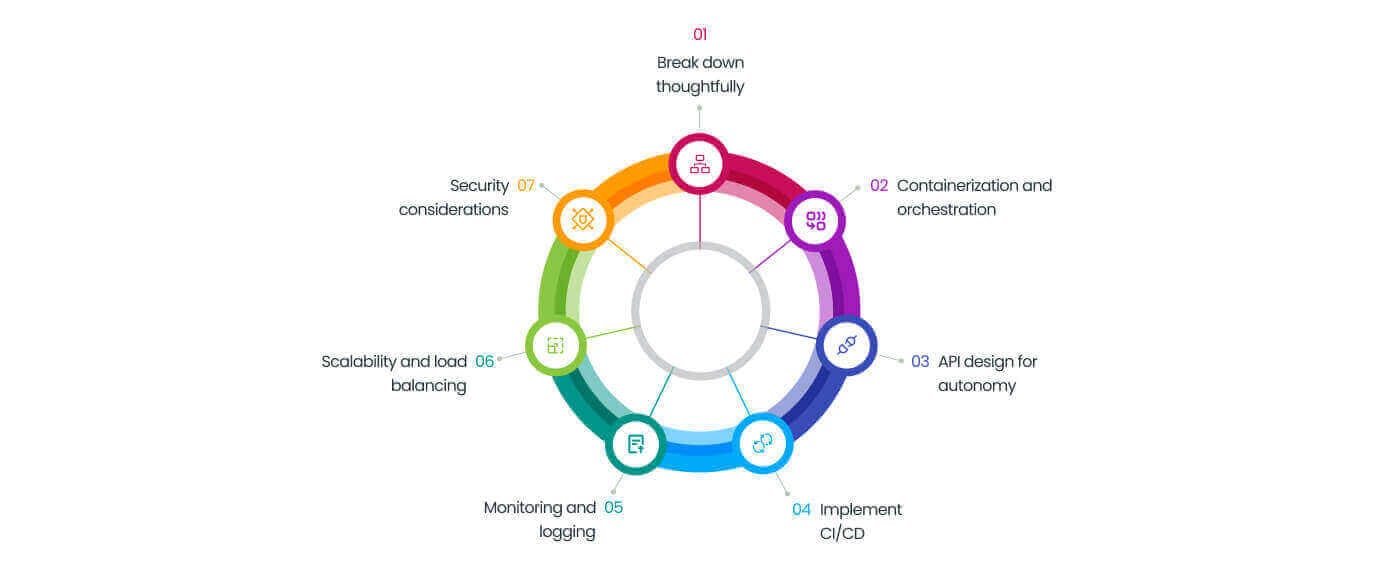 By Jophin December 20, 2023
3 min read
By Jophin December 20, 2023
3 min readTips to Scale Business with Microservices
In the modern business world, most startups and businesses have a vision of becoming a top player in the industry by offering a reliable service to their target customers. But most business-class people don’t scale their product or service based on the increasing needs of the users. It is the main reason behind the failure of most businesses in the global marketplace. Therefore, staying updated with the latest market trends and scaling your product with the right technology is imperative to surpass the rivals.
Currently, businesses from various industries are seeking innovative and creative ways to scale efficiently and adapt to evolving market demands. One such powerful strategy and innovative way that has gained prominence is the adoption of microservices. Microservices is a software architecture style, which breaks down applications into independently deployable services to fulfill a larger business goal.
As you know, scalability has become a vital requirement for businesses, organizations, enterprises, and startups. Monolithic applications are unable to match the performance demands made by modern businesses as customer demands increase. To overcome this hurdle, microservices architecture comes into play.
In this blog, we will explore the significance of microservices architecture in scaling businesses and provide seven valuable tips to leverage this architectural approach effectively. Let us begin with…
What is Microservice?
Microservices is often referred to as microservices architecture. It is a design paradigm that structures an application as a collection of small, independent services. Unlike traditional monolithic architectures, where a single, tightly integrated codebase handles all aspects of an application, this architecture breaks down the application into modular services. Each microservice is a self-contained unit responsible for a specific business capability and operates independently.
The key characteristic of microservices is their autonomy, which allows your development team to design, deploy, and scale individual services. This modular approach enhances agility, as updates to one service do not impact the entire application. Furthermore, each microservice has its database, which enables your developers to choose the most suitable technology for the specific functionality.
Microservices promote scalability and easier maintenance, which facilitates rapid development processes. Also, it empowers organizations to respond swiftly to changing market demands. This architectural approach has become increasingly popular as it assists businesses in building and scaling modern applications seamlessly. As already mentioned, scaling is imperative for long-term success. So, it’s time to understand the significance of microservice architecture in scaling.
Importance of microservice in scaling
The importance of microservices in scaling cannot be overstated. Here we list some essential aspects of Microservice architecture in scaling your business.
- This architecture enables businesses to scale with agility by breaking down applications into small, independently deployable services.
- With microservices, scalability is achieved through horizontal scaling, by adding more instances of a specific service to handle increased load.
- It facilitates easier maintenance and updates, as changes made to one service do not affect others. This scalability and flexibility are essential for businesses aiming to scale in a rapidly evolving business environment.
- Even if one service utterly fails, it does not influence the entire product or application. This isolation of faults ensures that issues are resolved within the affected service.
- It supports scalable development teams by allowing different teams to work on individual services.
- It provides the flexibility to scale specific services based on demand. This adaptability to changing workloads ensures that resources are allocated where they are needed most.
Now, let us jump onto the main topic of our blog.
Best tips to scale your business with Microservice
To grow your business successfully, you need to follow some best practices. Here we list some excellent tips for scaling your product or application seamlessly with microservice architecture.

1. Break down thoughtfully
Begin by strategically breaking down your monolithic application into microservices. Identify business domains and functionalities that can exist independently and encapsulate them into separate services. A well-thought-out breakdown is the foundation for a successful microservices architecture.
2. Containerization and orchestration
Embrace containerization technologies like Docker to package and isolate microservices. Container orchestration tools such as Kubernetes help manage the deployment, scaling, and operation of application containers. This ensures consistent and efficient deployment across various environments and streamlines the scaling process.
3. API design for autonomy
Design robust APIs to facilitate communication between microservices. APIs play a critical role in ensuring the autonomy of each service, allowing them to evolve independently. Well-defined APIs make it easier to upgrade services without disrupting the entire system.
4. Implement Continuous Integration/Continuous Deployment (CI/CD)
Automate your development pipeline with CI/CD practices. This ensures rapid and reliable delivery of microservices updates to production. Besides, it minimizes the development and deployment time significantly. CI/CD enhances the overall agility of your development process, which is a key factor in scaling your business application or product efficiently.
5. Monitoring and logging
Implement comprehensive monitoring and logging solutions to gain insights into the performance of your microservices. Real-time monitoring helps to identify and address issues promptly. Therefore, it ensures optimal system performance. Effective logging is imperative for troubleshooting and understanding the flow of data between services.
6. Scalability and load balancing
Design your microservices to scale horizontally by adding more instances of a service to handle increased load. Utilize load balancing techniques to distribute incoming requests across multiple instances, which ensures efficient resource utilization and improved system reliability.
7. Security considerations
Prioritize security throughout the microservices implementation. As a business owner or a startup, you can implement robust security measures at each layer, including authentication, authorization, and data encryption. Microservices often communicate over networks, which makes them susceptible to security threats. A powerful and high-end security strategy is vital to safeguard against potential vulnerabilities and protect sensitive data.
Follow these seven tips to scale your business app or website successfully with microservice architecture. Next, let us see.
Challenges in scaling business with Microservices
While microservices offer numerous advantages, they also hold some challenges that businesses must navigate. Such as
- One major challenge is the complexity of managing a distribution system.
- Coordinating communication between microservices and ensuring data consistency across services can be intricate.
- Additionally, monitoring and debugging in a microservices architecture demands specialized tools and practices.
- Striking the right balance between autonomy and coordination poses another challenge, as services must be independent and work seamlessly together.
Despite these challenges, businesses can overcome them with careful planning and the adoption of best practices.
Wrapping up
Microservices provide a powerful framework for businesses and enterprises aiming to scale efficiently in today’s competitive landscape. The agility, scalability, and autonomy offered by microservices make them valuable in meeting the demands of a dynamic market. By following the ideal tips outlined in this blog, you can harness the full potential of microservices and propel your business growth.
If you are a business owner or CXO of a company planning to scale your business with Microservice, then you will need an experienced software development company, who is well-versed in scaling products with this architecture approach. One such company in the global marketplace is Fortunesoft. We have a team of highly skilled and experienced professionals who specialize in microservices architecture. Our expertise ensures that your business benefits from a well-designed and efficiently implemented microservices ecosystem.
Understanding that each business has unique requirements, we provide tailored microservices solutions. With a focus on scalability and flexibility, our microservices solutions are designed to evolve with your business. This ensures that as your business grows, the architecture can easily adapt to increasing workloads and changing requirements.
Author Bio


 Facebook
Facebook Whatsapp
Whatsapp LinkedIn
LinkedIn Pinterest
Pinterest












 Start Chat
Start Chat